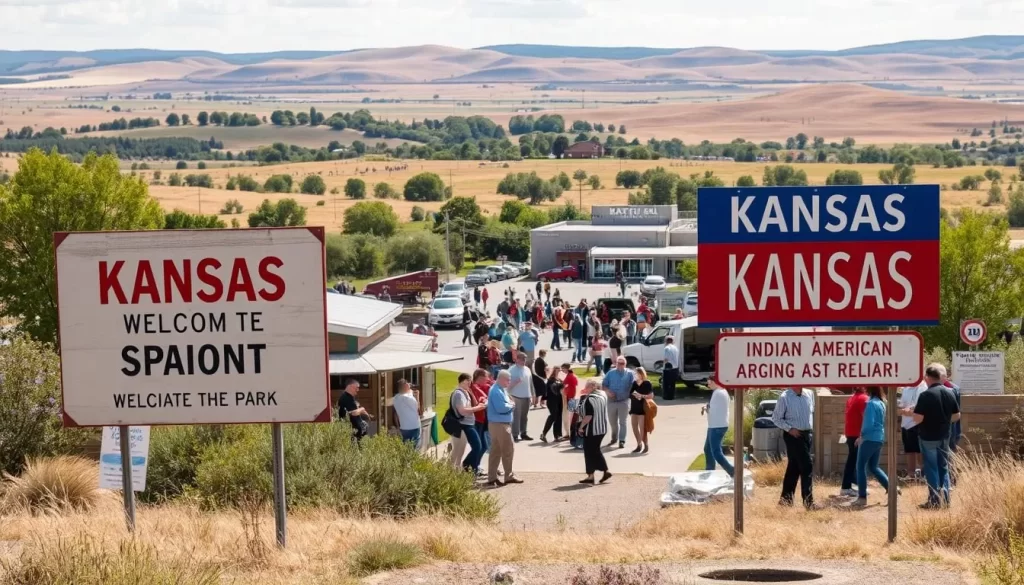✓ Accommodations ✓ Flights ✓ Rental Cars
You might be surprised to learn that Kansas, a state in the United States, is home to a rich tapestry of languages. While English is the official language, many residents bring their own linguistic traditions with them, shaping the state’s cultural identity.
Approximately 11.8% of residents aged five and above speak a language other than English at home. This diversity is a result of various immigration patterns that have influenced the state’s linguistic landscape over time.
As you explore the world of languages in Kansas, you’ll gain insights into the communities that maintain these linguistic traditions and understand the concept of Limited English Proficiency (LEP) and its implications for residents and service providers.
The Linguistic Landscape of Kansas
As you explore the linguistic landscape of Kansas, you’ll discover a diverse tapestry of languages spoken across the state. With a population of approximately 2.94 million people, Kansas is home to a multitude of languages that reflect its diverse demographic makeup.
English as the Official State Language
English is the official state language of Kansas, and it is spoken by the vast majority of the population. As the primary language used in government, education, and daily life, English plays a crucial role in the state’s linguistic landscape.
Language Diversity Statistics in Kansas
Kansas’s linguistic diversity is reflected in the data on languages spoken at home. Approximately 11.8% of residents aged five and up (about 346,584 people) speak a language other than English at home. Additionally, 4.51% of the population (around 132,465 residents) has limited English proficiency (LEP).

| Category | Statistic | Description |
|---|---|---|
| Total Population | 2.94 million | The total number of people living in Kansas |
| Language Other Than English at Home | 11.8% | Percentage of residents who speak a language other than English at home |
| Limited English Proficiency (LEP) | 4.51% | Percentage of the population with limited English proficiency |
The data highlights the importance of language access services in Kansas, particularly for immigrants and communities with limited English proficiency. As you can see, the linguistic diversity in Kansas is shaped by various factors, including immigration patterns and cultural preservation efforts.
Immigration History and Its Impact on Languages in Kansas
As you explore Kansas, you’ll discover that its languages are deeply rooted in its immigration history. The state’s linguistic landscape has been shaped by various immigrant groups over the years.
Indigenous Languages and Early Settlement
Kansas has been home to numerous indigenous tribes, each with their own distinct language. The early settlement of Kansas was marked by the presence of Native American languages, which played a significant role in shaping the region’s linguistic identity. These indigenous languages continue to be an essential part of Kansas’s cultural heritage.
Post-Civil War Immigration Patterns
The post-Civil War era saw a significant influx of immigrants from Europe, particularly from Germany and Scandinavia. These immigrants brought with them their languages and cultural practices, which eventually became an integral part of Kansas’s identity. The result was a diverse linguistic landscape, with various European languages being spoken across the state.

Modern Immigration Trends
In recent years, Kansas has experienced a growth in Hispanic and Asian populations. The Hispanic population, in particular, has continued to grow, contributing to the state’s linguistic diversity. You can see this diversity in the various languages spoken in Kansas, including Spanish, Vietnamese, Chinese, and Arabic. The table below highlights some of the key trends in Kansas’s modern immigration patterns.
| Immigrant Group | Primary Languages Spoken | Regions Settled |
|---|---|---|
| Hispanic | Spanish | Urban centers and agricultural areas |
| Asian | Vietnamese, Chinese | Urban centers |
| Middle Eastern | Arabic | Urban centers |
As a result of these immigration patterns, Kansas’s linguistic landscape continues to evolve, with new languages and cultures being introduced. This diversity is a testament to the state’s rich cultural heritage and its ability to adapt to changing demographic trends.
Top 10 Non-English Languages Spoken in Kansas
As you explore the linguistic diversity of Kansas, you’ll discover the top non-English languages spoken across the state. The Sunflower State is home to a rich tapestry of languages, reflecting its cultural heritage and the diverse backgrounds of its residents.
Spanish: The Most Widely Spoken Non-English Language
Spanish stands out as the most widely spoken non-English language in Kansas, with a significant number of speakers across the state. You can find Spanish being used in various contexts, from everyday conversations to community events and local businesses.
Vietnamese and Chinese Communities
The Vietnamese and Chinese communities in Kansas contribute significantly to the state’s linguistic diversity. You might notice the presence of these communities through their cultural events, restaurants, and community organizations. Vietnamese and Chinese languages are not only maintained within these communities but also influence the broader cultural landscape.
German: Historical Influence and Current Speakers
German has a historical influence on the language landscape of Kansas, with many German immigrants settling in the state. While the number of native German speakers has declined over time, you can still observe the legacy of German language and culture in certain communities and cultural practices.
Arabic and Middle Eastern Languages
Arabic and other Middle Eastern languages are also represented in Kansas, reflecting the diversity of the state’s population. You can find communities where these languages are spoken, often in conjunction with English, contributing to the state’s multicultural identity.
Thai, Lao, and Other Tai-Kadai Languages
Thai, Lao, and other Tai-Kadai languages are spoken by communities in Kansas, adding to the state’s linguistic richness. These languages are often maintained through community and cultural events, as well as through the efforts of cultural organizations.
Hindi and South Asian Languages
Hindi and other South Asian languages are represented in Kansas, reflecting the presence of South Asian communities. You might notice the influence of these languages in local culture, cuisine, and community life.
French and European Languages
French, along with other European languages, contributes to the linguistic diversity of Kansas. While not as widely spoken as some other languages, French and other European languages are maintained within specific communities and cultural contexts.
Swahili and African Languages
Swahili and other languages of Central, Eastern, and Southern Africa are spoken by an estimated 3,966 Kansas residents, making up about 0.15% of the population. You can observe that these language communities often have origins in refugee resettlement programs and more recent immigration. Speakers of African languages have established community organizations, religious institutions, and cultural events that help maintain their linguistic heritage.
Some key facts about Swahili and African languages in Kansas include:
- They collectively rank ninth among non-English languages in Kansas.
- These communities demonstrate high rates of multilingualism, with many speakers fluent in multiple African languages as well as English.
- African language communities are growing and developing resources to support newer immigrants and preserve cultural connections.

| Language Group | Estimated Number of Speakers | Percentage of Population |
|---|---|---|
| Spanish | High | Significant |
| Vietnamese and Chinese | Moderate | Notable |
| Swahili and African Languages | 3,966 | 0.15% |
| Other Languages | Varies | Varies |
English Proficiency Among Non-Native Speakers
You’ll notice that English proficiency varies significantly among non-native speakers in Kansas, impacting various facets of life. Understanding these variations is crucial for service providers, policymakers, and community leaders to ensure inclusivity and access to resources.
Limited English Proficiency (LEP) Statistics
Limited English Proficiency (LEP) refers to individuals who do not speak English as their primary language and have a limited ability to read, speak, write, or understand English. In Kansas, LEP statistics reveal a diverse linguistic landscape that requires attention to language access services. Data shows that a significant portion of the population speaks a language other than English at home.
Variations in English Proficiency by Language Group
English proficiency among non-native speakers in Kansas varies significantly across different language groups. As shown in the data, some language groups exhibit higher rates of English proficiency than others.

| Language | Percentage Speaking English ‘Very Well’ |
|---|---|
| Hindi | 90.3% |
| Swahili et al. | 85.1% |
| French | 84.3% |
| German | 80.6% |
| Spanish | 59.0% |
| Arabic | 53.9% |
| Chinese | 41.0% |
| Vietnamese | 38.5% |
| Korean | 38.5% |
You’ll observe that speakers of certain languages, such as Hindi and French, have higher English proficiency rates, while others, like Vietnamese and Korean, have lower rates. These variations reflect differences in immigration history, educational background, and community resources among language groups.
Language Access Services in Kansas
Kansas offers a range of language access services to bridge the communication gap between different linguistic communities. To cater to the needs of its diverse population, the state has implemented various initiatives.
Translation and Interpretation Services
Civil rights laws have pushed for better language access, requiring businesses and agencies that receive federal funding to provide interpreters and translated materials to help people with limited English. For instance, hospitals must translate vital documents into the 15 most common languages in their service areas.
Language Support in Healthcare and Government
You’ll find that language support is crucial in healthcare and government services. This support ensures that everyone has access to essential information and services, regardless of their linguistic background.
Educational Resources for Language Learners
Kansas offers various educational resources for both English language learners and those studying other languages. You can access:
- Adult education programs providing English as a Second Language (ESL) classes, often at low or no cost.
- K-12 schools offering English Language Learner (ELL) programs.
- Community organizations, libraries, and religious institutions providing informal language learning opportunities.
- Digital resources and language learning applications.
Conclusion: The Evolving Linguistic Diversity of Kansas
With the United States being one of the most linguistically diverse countries in the world, Kansas represents a microcosm of this diversity. As you’ve seen, the state’s linguistic landscape is characterized by English as the official state language, alongside numerous other languages that thrive throughout the state. The population of Kansas continues to evolve with changing immigration patterns and demographic shifts, creating both challenges and opportunities for communities and businesses.
You can appreciate how translation services, language education, and cultural awareness play important roles in building an inclusive environment for all Kansas residents. As the demographics of the United States continue to shift, adapting to the changing language needs is crucial. Today, Kansas’s linguistic diversity is a reflection of its connection to the world and its commitment to serving the needs of all language communities.
The above is subject to change.
Check back often to TRAVEL.COM for the latest travel tips and deals.






